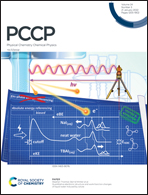A molecular insight into the photophysics of barbituric acid, a candidate for canonical nucleobases’ ancestor†
Abstract
This work investigates the photophysics of barbituric acid at different pH conditions using ab initio methods. Our calculations ascribe the most intense bands at ca. 260 nm at neutral pH and 210 nm at acidic pH conditions in the absorption spectra of this chromophore to the lowest lying ππ* transitions. Consistently with the ultrashort excited state lifetimes experimentally registered, the potential energy landscapes of both the neutral and deprotonated forms of barbituric acid combined with the interpretation of their transient absorption spectra suggest the deactivation of these systems along the singlet manifold. Compared to uracil, its closest natural nucleobase, barbituric acid presents a red shifted absorption spectrum, due to the lowering by more than 0.5 eV of the lowest-energy ππ* excited state, and a much more complex topography of the S1 potential energy surface, with several energetically accessible local minima. This fact, however, does not affect the excited state lifetimes, which for barbituric acid were experimentally registered in the sub-ps time scale.

- This article is part of the themed collection: 2022 PCCP HOT Articles


 Please wait while we load your content...
Please wait while we load your content...